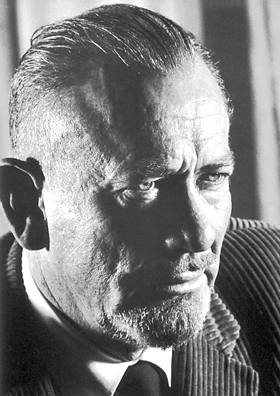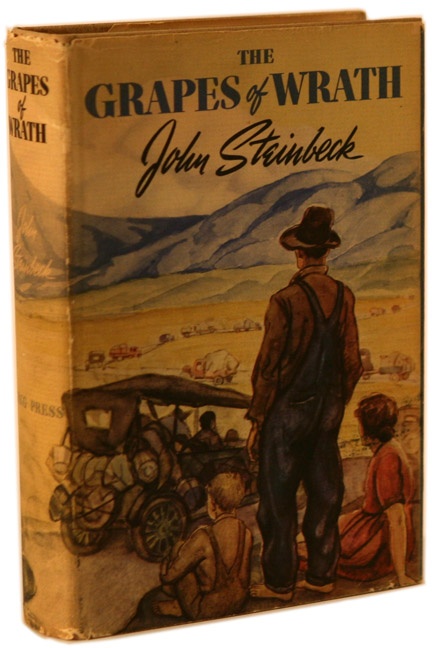On May 28, 1935, the world saw the release of Tortilla Flat. It would become John Steinbeck’s first truly successful book, heralding the arrival of a truly distinguished American voice. Steinbeck later went on to write more ambitious novels like East of Eden and The Grapes of Wrath, ultimately leading the author to a Nobel Prize in Literature. But before all that pomp and regard, there was a slim, comic novel about jolly laborers passing time in California.
 By what you were assigned in school, you might not have thought the works of John Steinbeck to be very funny. There isn’t much to laugh about, after all, in the morbid ending of Of Mice and Men or the Depression travails of the Joads. Yet humor was an important part of Steinbeck’s reputation. In 1962, when the Nobel committee recognized the author for his entire career, they were sure to give mention to the writer's "sympathetic humor."
By what you were assigned in school, you might not have thought the works of John Steinbeck to be very funny. There isn’t much to laugh about, after all, in the morbid ending of Of Mice and Men or the Depression travails of the Joads. Yet humor was an important part of Steinbeck’s reputation. In 1962, when the Nobel committee recognized the author for his entire career, they were sure to give mention to the writer's "sympathetic humor."
Tortilla Flat is a comic novel. It’s set in Monterey, a city not far from the author’s birthplace in Salinas. This central area of California meant much to Steinbeck, inspiring everything from settings of novels to his studies in marine biology.
Without the distinct culture of the area, Tortilla Flat would not have been possible. The book brings to life a group of paisanos, men of a heritage mixed with Spanish, indigenous, white, and Mexican genes. To the people of Monterey, they were minimally employable, and not worth inclusion in in the greater parts of society, but no matter. The paisanos had more elevated concerns—like friendship, good company, and wine.
The grand comic conceit of the book, as it’s known to writers of sketch comedy and sitcoms, is to “map” the world of the paisanos onto the court of King Arthur. Inheritances are not kingdoms but humble houses. Long ships do not carry fleets so much as paddle-driven boats contain fisherman. The spirits of the characters are high, but the stakes are much lower, making a fine comedy for many readers. The book’s release date, 1935, coinciding with the worst parts of the Great Depression, gave the humor an urgency. Most of its fans received it as a funny, romping work of escapism and carelessness. It was precisely what they needed in a difficult time.
Yet to see one of the 'Great White Men' illustrate people of color in such a way will naturally make us uncomfortable. What is perhaps surprising is how soon Steinbeck’s book was met with backlash. Almost immediately, the author was criticized for his portrayal of Hispanic Americans. Some saw his portrayal as stereotypical, harmful, and driven by not a sympathetic perspective as much as a condescending one. In the next edition of the book published by Modern Library in 1937, John Steinbeck penned a preface to address his critics:
When this book was written, it did not occur to me that paisanos were curious or quaint, dispossessed or underdoggish. They are people whom I know and like, who merge with their habitat. In men this is called philosophy, and it is a fine thing.
Had I known that these stories and these people would be considered quaint, I think I never should have have written them… If I have done them harm by telling a few of their stories I am sorry. It will never happen again.
The author’s passionate apologia was never printed again, and the 1937 Modern Library edition remains a coveted book among collectors.
 Steinbeck’s convincing sincerity aside, there are many Mexicans who find his depictions troublesome. In the '70s, Philip D. Ortego penned an essay against the book’s politics. “To believe Steinbeck’s descriptive diagnosis of the Chicano ethos in Tortilla Flat,” he argues, “is to reinforce the most prevalent stereotypes and caricatures about Chicanos.” What we have on our hands is a “sad book in more ways than John Steinbeck may have ever imagined.”
Steinbeck’s convincing sincerity aside, there are many Mexicans who find his depictions troublesome. In the '70s, Philip D. Ortego penned an essay against the book’s politics. “To believe Steinbeck’s descriptive diagnosis of the Chicano ethos in Tortilla Flat,” he argues, “is to reinforce the most prevalent stereotypes and caricatures about Chicanos.” What we have on our hands is a “sad book in more ways than John Steinbeck may have ever imagined.”
Another critic has pointed out how the paisanos in the novel are “freaks,” with the ability to drink copiously with no consequences. Many have felt, and continue to feel, that Steinbeck’s limited vision serves to diminish the dignity of Mexican-Americans. It is hard to blame them for feeling this way.
It seems very likely that Steinbeck wrote the world of Tortilla Flat with immense sympathy and care, all the while distorting—if not undermining—the culture of a people. Steinbeck, who was always wary of the effect money had on the soul, genuinely adored the paisanos, who brought far more important things, like friendship, community, and symbiosis to a glorious height. For in Steinbeck’s philosophical mind, the paisanos had something to teach us about living in happiness and harmony. But there were other other barriers—racial, cultural, and political ones—that Steinbeck seems to have thought about less, preventing him from seeing the full picture.
It is the job of the fiction writer to examine the manifold ways in which we don’t get along. The miscommunications surrounding Tortilla Flat remind us why it is often so easy to fail in our understanding of each other.









